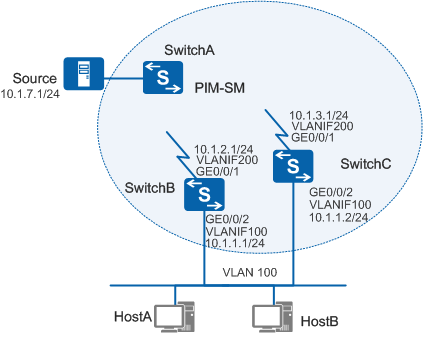Example for Configuring PIM BFD
Networking Requirements
In Figure 1, basic PIM-SM configuration has been completed on the Switches. User hosts receive multicast data from the multicast source. SwitchA is the source designated router (DR). SwitchB and SwitchC are connected to the user host network segment. When the receiver DR changes, other switches are required to fast respond to the change.
You can set up Bidirectional Forwarding Detection (BFD) sessions on the user host network segment so that switches can fast respond to the change of the DR. In addition, you can configure the DR switchover delay. When a Switch is added to the network segment and may become a DR, the multicast routing table of the original DR is reserved until routing entries of the new DR are created. Therefore, the packet loss due to the delay in creating multicast entries is prevented.

After the DR switchover delay is configured, the downstream receivers will receive two copies of the same data during the DR switchover, which will trigger the assert mechanism. To prevent triggering the assert mechanism, it is recommended that DR switchover delay is not configured.
Configuration Roadmap
The configuration roadmap is as follows:
Configure PIM BFD on interfaces that connect the Switch to the user host network segment.
Configure the PIM DR switchover delay on interfaces that connect the Switch to the user host network segment.

This configuration example describes only relevant PIM-SM BFD commands.
Procedure
- Enable BFD globally and configure PIM BFD in the interface view.
Enable BFD globally on SwitchB and SwitchC and enable PIM BFD on interfaces connecting to the user host network segment and configure PIM BFD parameters. The configuration of SwitchC is similar to the configuration of SwitchB, and is not mentioned here.
[SwitchB] bfd [SwitchB-bfd] quit [SwitchB] interface vlanif 100 [SwitchB-Vlanif100] pim bfd enable [SwitchB-Vlanif100] pim bfd min-tx-interval 100 min-rx-interval 100 detect-multiplier 3
- Configure the PIM DR switchover delay.
# Configure the PIM DR delay on SwitchB and SwitchC. The configuration of SwitchC is similar to the configuration of SwitchB, and is not mentioned.
[SwitchB-Vlanif100] pim timer dr-switch-delay 20 - Verify the configuration.
Run the display pim interface verbose command to check information on the PIM-enabled interface. The information about the PIM-enabled interface on SwitchB indicates that the DR on the host network segment is SwitchC. PIM BFD is enabled on the interface and the switchover delay is configured.
<SwitchB> display pim interface vlanif100 verbose VPN-Instance: public net Interface: Vlanif100, 10.1.1.1 PIM version: 2 PIM mode: Sparse PIM state: up PIM DR: 10.1.1.2 PIM DR Priority (configured): 1 PIM neighbor count: 1 PIM hello interval: 30 s PIM LAN delay (negotiated): 500 ms PIM LAN delay (configured): 500 ms PIM hello override interval (negotiated): 2500 ms PIM hello override interval (configured): 2500 ms PIM Silent: disabled PIM neighbor tracking (negotiated): disabled PIM neighbor tracking (configured): disabled PIM generation ID: 0XF5712241 PIM require-GenID: disabled PIM hello hold interval: 105 s PIM assert hold interval: 180 s PIM triggered hello delay: 5 s PIM J/P interval: 60 s PIM J/P hold interval: 210 s PIM BSR domain border: disabled PIM BFD: enabled PIM BFD min-tx-interval: 100 ms PIM BFD min-rx-interval: 100 ms PIM BFD detect-multiplier: 3 PIM dr-switch-delay timer : 20 s Number of routers on link not using DR priority: 0 Number of routers on link not using LAN delay: 0 Number of routers on link not using neighbor tracking: 2 ACL of PIM neighbor policy: - ACL of PIM ASM join policy: - ACL of PIM SSM join policy: - ACL of PIM join policy: -# Run the display pim bfd session command to check information about the BFD session on SwitchB. You can check whether the BRD session is set up.
<SwitchB> display pim bfd session VPN-Instance: public net Total 1 BFD session Created Vlanif100 (10.1.1.1): Total 1 BFD session Created Neighbor ActTx(ms) ActRx(ms) ActMulti Local/Remote State 10.1.1.2 100 100 3 8192/8192 Up# Run the display pim routing-table command to view the PIM routing table. SwitchC functions as the DR. The (S, G) and (*, G) entries exist. The following information is displayed.
<SwitchC> display pim routing-table VPN-Instance: public net Total 1 (*, G) entry; 1 (S, G) entry (*, 225.1.1.1) RP: 10.1.5.2 Protocol: pim-sm, Flag: WC UpTime: 00:13:46 Upstream interface: Vlanif200 Upstream neighbor: 10.1.2.2 RPF prime neighbor: 10.1.2.2 Downstream interface(s) information: Total number of downstreams: 1 1: Vlanif100 Protocol: igmp, UpTime: 00:13:46, Expires:- (10.1.7.1, 225.1.1.1) RP: 10.1.5.2 Protocol: pim-sm, Flag: SPT ACT UpTime: 00:00:42 Upstream interface: Vlanif200 Upstream neighbor: 10.1.2.2 RPF prime neighbor: 10.1.2.2 Downstream interface(s) information: Total number of downstreams: 1 1: Vlanif100 Protocol: pim-sm, UpTime: 00:00:42, Expires:-
Configuration Files
SwitchA needs to be configured with only basic PIM SM functions. The configuration file is not provided here.
- SwitchB has the following configuration file. The configuration file of SwitchC is similar to that of SwitchB and is not provided here.
# sysname SwitchB # vlan batch 100 200 # multicast routing-enable # bfd # interface Vlanif100 ip address 10.1.1.1 255.255.255.0 pim timer dr-switch-delay 20 pim sm pim bfd enable pim bfd min-tx-interval 100 min-rx-interval 100 igmp enable # interface Vlanif200 ip address 10.1.2.1 255.255.255.0 pim sm # interface GigabitEthernet0/0/1 port link-type trunk port trunk allow-pass vlan 200 # interface GigabitEthernet0/0/2 port link-type hybrid port hybrid pvid vlan 100 port hybrid untagged vlan 100 # ospf 1 area 0.0.0.0 network 10.1.1.0 0.0.0.255 network 10.1.2.0 0.0.0.255 # return
